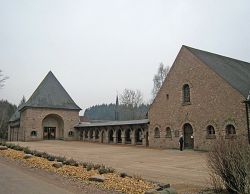In the common vocation
For various reasons, in these months again some brothers and sisters visited or stayed at different monasteries and communities: for some it was preaching, for others various motives of work or study, for others a retreat, and for still others a simple desire of a fraternal visit
For various reasons, in these months again some brothers and sisters visited or stayed at different monasteries and communities: for some it was preaching, for others various motives of work or study, for others a retreat, and for still others a simple desire of a fraternal visit.
In March our prior, br Enzo, visited the monastery of Camaldoli, where he participated at the VIIIth Assembly of the Italian Monastic Conference (CIM, of which our community is a member as of last year). He spoke on The Word of God and Monastic Life. In this period also br Edoardo and br Goffredo visited the same monastery: br Edoardo for a session of the Jewish-Christian Colloquium and br Goffredo to represent our community at the solemn profession of br. Matteo. For a personal retreat sr Lucia went to the Valserena monastery, while sr Roberta visited the Benedictine monastery “Mater Ecclesiae” of Isola S. Giulio, sr Ilaria and sr Roberta the Carmel of Biella-Chiavazza, sr Anna the monastery of Civitella San Paolo, sr Laure the monastery of Echourgnac, sr Natalia the Cistercian monastery of Kismaros (Hungary), br Raffaelo and br Luigi the monastery of Simonos Petras (Mount Athos), sr Raffaela the monasteries of Cîteaux and of La Pierre-qui-Vire. For a brief stay of formation br Marcello visited the monastery of En Calcat, br Ezio that of Tamié, and br Lorenzo that of La Pierre-qui-Vire; br Giuseppe and br Goffredo also visited this last, for sessions held by br Goffredo with the community on liturgical space. Archival research brought br Matteo to the monastery of St André de Bruges (Zevenkerken Abdij, Belgium), while sr Sylvie and sr Francesca took occasion of the annual meeting of Reformed French and Swiss communities to spend a few days also at Taizé. Br Luciano participated at the meeting of the directors and directresses of novices of France and Switzerland organized at the Cistercian monastery of Hauterive.
Equally fruitful and welcome were the numerous visits of monks and nuns in these months as at other times. We welcomed m. Maria Pia, recently elected abbess of the monastery of Civitella San Paolo; m. Maria Ignazia, abbess of the Benedictine monastery of Viboldone, who preached the annual retreat to the community in January; then fr Pius Ramon of the monastery of Monserrat, fr Maurice of Boscodan abbey; fr Matteo of Camaldoli; sr Michela and sr Lourdes of the Camaldolese monastery of St Antony in Rome; sr Myriam and sr M. Benedetta of the Capuchin Poor Clares monastery of Oristano; fr Ivo of the monastery of Westmalle, at present chaplain of the Trappist monastery of Vitorchiano; br Emmanuel, French Premonstratensian canon of the abbey of St Michel de Frigolet; fr Filaret of the Kiev Caves Lavra; fr Joseph of a nascent Romanian monastery of the Greek-Catholic Church in Lugoj. Especially significant, if brief, was the passage of eight Chinese novices, accompanied by br Markus of the Benedictine abbey of St Ottilien (Germany), where they are at present spending their period of formation, with the intention, however, of returning soon to their own country to start a new monastic foundation. Our community has been following this project with interest and hope for quite some time, thanks especially to the contacts of br Matteo and his research on the Church in China.
Finaly, we would like to express our fraternal sentiments to the Trappist community of Bellefontaine, in mourning for the recent death pf dom Emmanuel, its former abbot, to whose memory we are especially bound, because he welcomed with kindness br Enzo in 1967, at the beginnings of our community life, and gave him as gift a white hooded monastic habit, which our community later adopted as its liturgical habit.
